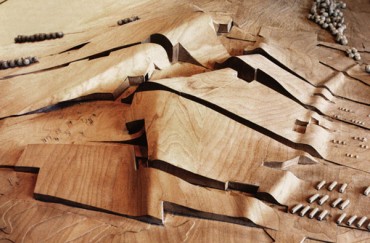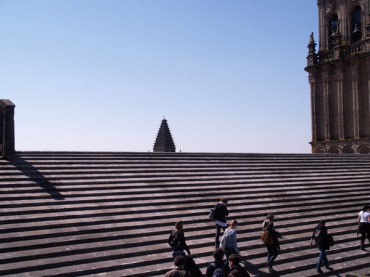Selected Topic
Issue 1 - After Crisis – Contemporary Architectural Conditions (Feb 2011)
Show articles
Peter Eisenman, Cidade da cultura, 1999- in progress, wooden model

Jørn Utzon, Platform in Yucatan, in Zodiac 10, 1962

Cidade da Cultura in construction, March 2009

Santiago Cathedral roofscape, March 2009
4.7.2012 – Issue 1 - After Crisis – Ivanišin Krunoslav – Essays
“HOW ONE CAN BUILD A MOUNTAIN ...
by Krunoslav Ivanisin
… and then not let people climb on top of this mountain?” I was asked this question by one student during the seminar trip to Galicia in March 2009. More precisely, during our visit to the Cidade da Cultura; the pharaonic-sized project that has been under construction since 2001, upon Peter Eisenman’s 1999’s competition-winning entry: naïve ignorance but also authentic experience confronting what is supposed to become a great work of the twenty-first-century architecture.
One may argue how it is unjust to qualify a work of architecture imbued with many philosophical and theoretical issues by questions from students who are merely embarking along the path toward becoming architects. But once the intellectual exercise is embodied in the material world, especially on such an enormously large public scale, it inevitably becomes the topic of discussion, considering the logic of its parts, its relation to the surroundings, all the way down to the prosaic aspects of its economical performance.
Even though it is possible that the “authentic” and “naïve” question is not much more than reinterpretation of the trendy criticism habitually aimed at works of architecture from the most recent periods, it is certainly worth our consideration in a context broader than the “mountain” in question itself.
Jørn Utzon published his “Platforms and Plateaus” in Zodiac 10 in 1962 (1). He wrote about the constructed mountain there: the giant platform in Yucatan amid the dark jungle with the sunlit temple on top of it. By raising the platform exactly to the height of the top of the surrounding jungle, a spatial condition was created which radically opposed the given natural surrounding. “Suddenly the jungle roof had been converted into a vast, open plain”; Mayans were given the sensation of horizon they previously had none of. “Platforms” are something greater than their surroundings, in terms of wild nature, the picturesque landscape or the big city. Still, the physical shape of the surroundings is their reference. “Platforms” are pediments for “architecture,” closer to natural constructions and infrastructural works than to architecture itself. The relations that they establish with their surroundings are similar to those of great infrastructure projects. Driven by pure engineering logic, they occupy strategic positions within the given landscape. Over the course of time, sometimes they become native, blending with the site they were originally imposed on.
“Platforms and Plateaus” could be considered a post-manifesto for Utzon’s Sidney Opera project, which was under construction while the text was written. Code X is a collection of essays and drawings that explicates Peter Eisenman’s theory of coding as a form-generating device (2). In “Coded Rewritings: The Process of Santiago” Eisenman rewrites his own work from the siteless houses, finally incarnated in the earthwork of the inhuman proportions on top of Monte Gaiás (3).
This hill indeed overlooks Santiago de Compostela, but in fact it is not much more than just any hill, hardly worthy of this gigantic effort. The mountaintop has been lopped off here, to be constructed anew in a building cut into slices, which is to house Galician cultural institutions. The mythical code informs this reconstructed mountain. It has been developed in an impressive computer-aided geometrical operation through the superimposition of the pattern of the medieval city, which just happened to be on the neighboring hill, the original topography of the destroyed hill and a disenchanting Cartesian grid laid a priori over everything.
Even though the neighboring city is an important reference for the hill we are concerned about here, its entire complexity has been reduced to a flat image, albeit in an attempt to inform a new complexity, never seen before. In spite of all the intellectual effort invested manipulating the historical and topographical matrix, and all the technical effort invested in overcoming the violations of the mechanical logic of architecture caused by the obsessive insistence on the Cartesian grid, the Cidade da Cultura is clearly a nonnative building. It is more an oversized mock-up; one million square feet that is just that part of an iceberg visible over the sea surface! (The remainder, which at first glance is invisible, in this case, would be the contemporary construction industry’s decisive contribution to the dismantling of the civic legacy of the post–World War II Europe.)
The end result is disappointingly of this world, with figural (that is, solid) and residual (that is, void) spaces, plus lots of literally leftover spaces captured between the interior and the exterior skins of the slices that constitute the mountain. One could freely wonder what would happen if one day somebody ventures to flatten this image to develop another code that would inform the rebuilding of the top of another hill. Et cetera.
Finally, even in the case of our being convinced that the Cidade da Cultura is a great work of architecture, the question from the beginning of this text is still in the air: why can nobody can climb to the top of it? Especially when confronted with physical evidence of a much older mountain constructed on top of the neighboring hill that has allegedly informed the mountain concerned here: The pitched roofs of the Santiago de Compostela cathedral are covered with granite plates, which form a series of steps. In older times, pilgrims used to climb up them to ritually burn their old clothes worn on the pilgrimage. Nowadays the extraordinary experience of walking on top of the city costs only 10 euros. This roofscape is proof of the Dutch traveler’s unprovable belief.
Indeed “there are some places in the world where one is mysteriously magnified on arrival or departure by the emotions of all those who have arrived and departed before.” (4) No mythical code, only normal duration and use constitute architectural complexity here.
1. Jørn Utzon, “Platforms and Plateaus: Ideas of a Danish Architect,” Zodiac 10 (1962): 113.
2. Eisenman Architects, Code X: The City of Culture of Galicia (New York: The Monacelli Press, 2005).
3. Peter Eisenman, “Coded Rewritings: The Process of Santiago ,” in ibid., 27.
4. Cees Nooteboom, Roads to Santiago (New York: Harcourt Brace, 1997), 3.
Download article as PDF

